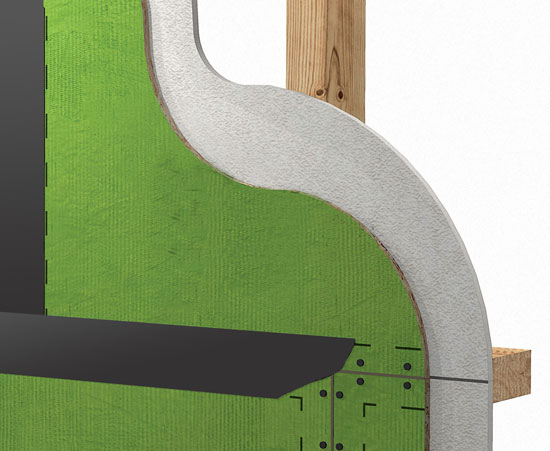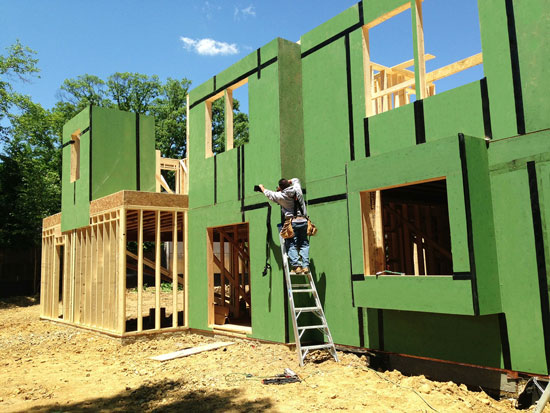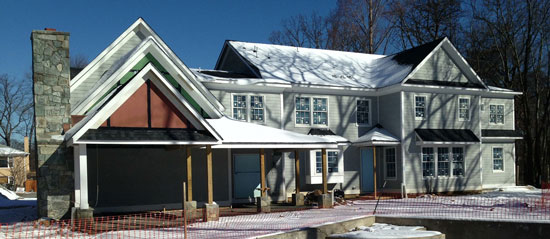Code Compliant Exterior Systems for Wood-Framed Building Envelopes
Thermal Performance
Thermal performance of a building, meaning the ability to retain or restrict the flow of heat between inside and outside, is the topic most people associate with the IECC when it comes to building envelopes. As discussed above, there are certainly other considerations, but thermal performance remains a key requirement of wood-framed construction and is treated in significant detail in the building envelope portion of the IECC for both residential and commercial buildings.
Here too, the key definitions are found in the IECC (IECC 202), including:
• Building Thermal Envelope: The basement walls, exterior walls, floor, roof, and any other building elements that enclose conditioned space or provide a boundary between conditioned space and exempt or unconditioned space.
• Continuous Insulation (ci): Insulating material that is continuous across all structural members without thermal bridges other than fasteners and service openings. It is installed on the interior or exterior, or is integral to any opaque surface, of the building envelope.
• U-Factor (Thermal Transmittance): The coefficient of heat transmission (air to air) through a building component or assembly, equal to the time rate of heat flow per unit area and unit temperature difference between the warm side and cold side air films (Btu/h · ft2 · °F) [W/(m2 · K)].
• R-Value (Thermal Resistance): The inverse of the time rate of heat flow through a body from one of its bounding surfaces to the other surface for a unit temperature difference between the two surfaces, under steady state conditions, per unit area (h · ft2 · °F/Btu) [(m2 · K)/W].
Code compliance on thermal performance begins with identifying the climate zone for the building project. The building type (commercial or residential) then comes into play, and the IECC uses charts and tables to identify the minimum performance requirements for the entire building thermal envelope. In many climate zones, it is no longer enough to simply provide insulation materials between the wood-framing members, since the wood framing itself has been demonstrated to compromise the effectiveness of the insulation. Rather, many wall and roof assemblies also require continuous insulation under the code to reduce the effects of “thermal bridges,” which allow heat to conduct through the wood framing (IECC C402 and R402). Traditionally, the insulation has been applied to the exterior side of the wall on one side or the other of the sheathing. The intent is to cover all wall framing, floor framing, etc. with a layer of insulation that is continuous around the entire building thermal envelope. In most climate zones where this applies, one or two inches of rigid insulation (R-5 or R-10) is called for. It is important to note that making it continuous around the full envelope requires some attention to detail, such that the interface of the wall continuous insulation meets and extends with continuous insulation in the roof and floor or basement insulation.
Recognizing the need for integration of the continuous insulation with the rest of the components, one manufacturer has introduced a sheathing panel with multiple layers integrated during the manufacturing process. These layers include a fused WRB that also acts as an air barrier on the face of the structural sheathing and adhered foam insulation on the back of the panel. This provides a nailable wood base for attaching exterior cladding, while providing the needed air and water resistive barriers on the exterior.
It is also worth noting that the IECC allows two ways to calculate the thermal performance of a building, whether residential or commercial. The simple choice is to select insulating products that are labeled to show minimum R-values that are equal to or greater than the code-required R-values prescribed for a particular building type in a particular climate zone. These tables take into account standard wood-framed construction and adjust the R-values appropriately recognizing that the performance of the total wall or roof assembly will be somewhat less. The alternative approach is to calculate the U-factor of the assembly using recognized and standardized methods. This method is more precise for specific construction assemblies and is generally used when some details of non-conventional construction may be employed.
Installing insulation between framing members during construction is commonly done after all mechanical and electrical rough-in work is finished and just prior to the installation of interior gypsum board or other finishes. If continuous insulation is installed on the interior surface, then it would be applied at this time too, although it does create some coordination and finish issues to have an extra inch or two of material extending into a living space. That is part of the reason continuous insulation is installed on the outside of studs at the same time as structural sheathing. If one insulation contractor is to install both types of insulation, then they are likely making multiple job-site visits and needing to coordinate with the framers and other subcontractors that may be applying WRBs, air barriers, and siding.

Photo used with permission of Huber Engineered Woods LLC ©2012
One way to add R-value to wall assemblies is to use single-panel sheathing systems with a built-in layer of continuous foam insulation integral to the back of the panel.
There are structural sheathing products available, however, that combine with rigid, continuous insulation, such that one panel provides both insulation and structural sheathing in one application. This saves installation time, reduces the amount of coordination required, and improves on-site quality control—applicable to the entire building thermal envelope including exterior walls.
Conclusion
We have seen how building codes and energy codes separately address the much related five performance issues of structural integrity, water resistance, vapor control, air tightness, and thermal performance. We have also reviewed some of the requirements and options available in terms of products and materials that can meet the various code requirements. Notably, the construction-products industry, in general, is seeking to provide architects, builders, and contractors with systems that can meet more than one of these five needs. In fact, at least one manufacturer provides structural sheathing with a layer of continuous insulation on one side and a pre-installed surface on the other that meets the requirements for both a water-resistive barrier and an air barrier. The use of continuous adhesive tape in the field plus related flashing provides the continuity and integrity of the system needed to meet code requirements. Ultimately, systems such as this go beyond meeting only code requirements and also provide a faster installation with increased quality control, single-source responsibility for warranty, ease of inspections, and long-term durability for building owners. Understanding all of the options available and the impact on installation, cost, and efficiency are critical to not only the initial code compliance of an exterior wood-framed wall, but also its long-term performance.

|
Huber Engineered Woods |










